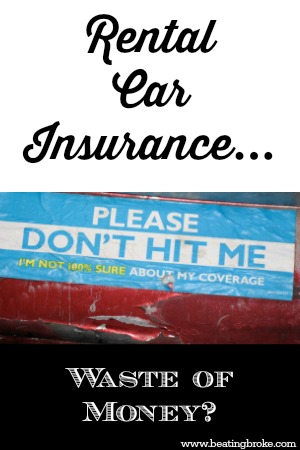I recounted in my last post the many adventures we had driving 1,750 miles from Illinois to Arizona where we damaged not one, but two rental cars. We saved $100 by not purchasing the rental car company’s auto insurance, but that decision cost us $500 in our deductible. Not my brightest move ever.
If you think, like I did, that a rental car company’s insurance is a scam that should be avoided like the plague, here are some reasons why you might want to reconsider:
The Rental Car Company Has a Different Standard Than You
 The rental car company we used said any damage smaller than the size of a quarter, they would let slide. Anything bigger than that, and it needed to be repaired.
The rental car company we used said any damage smaller than the size of a quarter, they would let slide. Anything bigger than that, and it needed to be repaired.
Any time you drive a car, you risk bumps and scratches to the car’s exterior. I have a large scratch on the back of my vehicle that I find annoying, but not worth the price of paying my $500 deductible. I’m guessing your own vehicle has similar scratches and dents. They’re minor, and you don’t want to spend the money to repair them.
The choice is yours because it’s your vehicle. However, if it’s bigger than a quarter, the rental car company is going to make the repair, and you will pay if you don’t take out the rental car company’s insurance.
Your Insurance Premium May Go Up
Another reason people let minor dents and scratches on their own vehicles slide is because they don’t want to face a claim and risk having their insurance go up.
Some people even do this for more major repairs. Several years ago, a man rear-ended me, and he chose to pay the $1,400 for the repair to me directly so he could avoid submitting the claim to his insurance and risk having his premium go up.
If you don’t purchase the rental car company’s auto insurance, you’ll have to choose to pay out of pocket or to risk having your premium go up.
How to Decide If You Should Purchase Insurance from the Rental Car Company
To decide whether or not purchasing insurance from the rental car company is worthwhile, ask yourself these questions:
1. Have you made any claims on your insurance in the last three to five years? If so, you will probably want to purchase the rental insurance; in the long run, that will be cheaper than facing a spike in your insurance.
2. How far do you have to drive? Of course, accidents can happen anywhere, but if you’re renting a car for the weekend and driving it around your hometown, you may be able to avoid rental insurance. Our problem was that we were driving 3,500 miles round trip in an area we were unfamiliar with. Things like dead deer and street sweepers on the highway pose risks that you can’t foresee before the trip
3. How high is your deductible? If your deductible is anywhere from $500 to $1,000, purchasing rental insurance may be smarter, especially if it is going to be less than $100.
What is your opinion? Purchase car rental auto insurance or just rely on your own car insurance?
Original img credit: Insurance Disclaimer on Flickr
Melissa is a writer and virtual assistant. She earned her Master’s from Southern Illinois University, and her Bachelor’s in English from the University of Michigan. When she’s not working, you can find her homeschooling her kids, reading a good book, or cooking. She resides in New York, where she loves the natural beauty of the area.

 I was proud of my penny pinching ways until our first night on the road. We were driving along a desolate stretch in Oklahoma; it was dark, and we were ready to stop for the night. A semi was in front of us and swerved at the last minute. We had no time to wonder why; a deer carcass was straight in our path. Even though my husband swerved, he still hit it. We felt the thump under our car and feared the worst.
I was proud of my penny pinching ways until our first night on the road. We were driving along a desolate stretch in Oklahoma; it was dark, and we were ready to stop for the night. A semi was in front of us and swerved at the last minute. We had no time to wonder why; a deer carcass was straight in our path. Even though my husband swerved, he still hit it. We felt the thump under our car and feared the worst. Once you know the requirements of the state and any lien holders, you’ve got to decide on the level of car insurance coverage you want. There are two ways to look at this. The first is that you’ve got to find a coverage and provider that is affordable enough to fit into your budget. The second is usually the forgotten way of looking at insurance. The coverage doesn’t just have to fit into your budget, it also needs to cover you against a total loss. If you have full coverage, but it’s only enough to cover a portion of what you owe on the car, you’ll also want to look at something that’s usually called “Gap Insurance”. Gap insurance is aptly named in that it is designed to cover any gap between the value of the car and the remaining loan should the car be totaled before you pay it off. Car insurance can be a combination of three coverages. A liability coverage (usually what States require), Comp & Collision, and personal injury. The exact levels that you need will vary based on your situation, but your insurance provider should be able to make recommendations for you.
Once you know the requirements of the state and any lien holders, you’ve got to decide on the level of car insurance coverage you want. There are two ways to look at this. The first is that you’ve got to find a coverage and provider that is affordable enough to fit into your budget. The second is usually the forgotten way of looking at insurance. The coverage doesn’t just have to fit into your budget, it also needs to cover you against a total loss. If you have full coverage, but it’s only enough to cover a portion of what you owe on the car, you’ll also want to look at something that’s usually called “Gap Insurance”. Gap insurance is aptly named in that it is designed to cover any gap between the value of the car and the remaining loan should the car be totaled before you pay it off. Car insurance can be a combination of three coverages. A liability coverage (usually what States require), Comp & Collision, and personal injury. The exact levels that you need will vary based on your situation, but your insurance provider should be able to make recommendations for you.